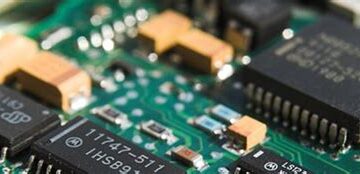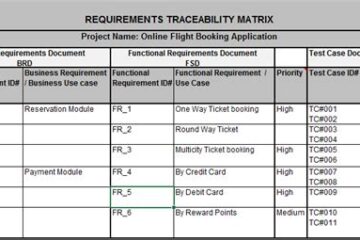Common BGA Soldering Errors
Several factors can contribute to BGA soldering defects, such as improper solder paste application, incorrect reflow profile, poor package handling, and PCB design issues. The following are some of the most common BGA soldering errors:
- Bridging
- Open joints
- Head-in-pillow (HIP)
- Solder Voids
- Misalignment
- Tombstoning
- Solder Beading
- Insufficient or excessive solder
- Lifted Pads
- Damaged packages
Let’s discuss each error category in detail.
Bridging
Bridging occurs when solder forms an unintended connection between two or more adjacent solder balls, creating a short circuit. Bridging can be caused by:
- Excessive solder paste deposition
- Incorrect stencil design or thickness
- Poor paste release from the stencil
- Inadequate solder mask clearance between pads
- Improper reflow profile (high peak temperature or long time above liquidus)
To prevent bridging, consider the following:
- Optimize stencil aperture design and thickness
- Ensure proper solder paste viscosity and printing parameters
- Maintain adequate solder mask clearance between pads (typically 0.1-0.15 mm)
- Use an appropriate reflow profile with controlled peak temperature and time above liquidus
Open Joints
Open joints occur when there is no electrical connection between the BGA ball and the PCB pad. Open joints can be caused by:
- Insufficient solder paste deposition
- Poor wetting of the solder to the pad or ball
- Contamination on the pad or ball surface
- Oxidation of the pad or ball surface
- Incorrect reflow profile (low peak temperature or short time above liquidus)
To prevent open joints, consider the following:
- Ensure adequate solder paste deposition using the correct stencil design and printing parameters
- Clean the PCB and BGA package to remove contaminants
- Use a nitrogen reflow environment to minimize oxidation
- Optimize the reflow profile with sufficient peak temperature and time above liquidus
Head-in-Pillow (HIP)
Head-in-pillow (HIP) defects occur when the BGA ball does not collapse completely onto the PCB pad, resulting in a partial or no electrical connection. HIP defects can be caused by:
- Poor wetting of the solder to the pad or ball
- Oxidation of the pad or ball surface
- Contamination on the pad or ball surface
- Incorrect reflow profile (low peak temperature or short time above liquidus)
- Warpage of the PCB or BGA package during reflow
To prevent HIP defects, consider the following:
- Ensure proper solder paste selection and deposition
- Clean the PCB and BGA package to remove contaminants
- Use a nitrogen reflow environment to minimize oxidation
- Optimize the reflow profile with sufficient peak temperature and time above liquidus
- Control PCB and BGA package warpage through proper design and material selection
Solder Voids
Solder voids are air pockets trapped within the solder joint, which can reduce the mechanical strength and electrical conductivity of the joint. Solder voids can be caused by:
- Outgassing from the PCB laminate, solder mask, or solder paste
- Inadequate flux activity or incorrect flux type
- Incorrect reflow profile (rapid heating or cooling rates)
- Contamination on the pad or ball surface
To prevent solder voids, consider the following:
- Select PCB materials with low moisture absorption and outgassing
- Use solder paste with appropriate flux activity and type
- Optimize the reflow profile with controlled heating and cooling rates
- Clean the PCB and BGA package to remove contaminants
Misalignment
Misalignment occurs when the BGA package is not properly aligned with the PCB pads, resulting in off-center or incomplete solder joints. Misalignment can be caused by:
- Incorrect placement of the BGA package during assembly
- Poor fixturing or support of the PCB during reflow
- Warpage of the PCB or BGA package during reflow
- Incorrect PCB pad design or spacing
To prevent misalignment, consider the following:
- Use precise placement equipment and techniques
- Provide adequate fixturing and support for the PCB during reflow
- Control PCB and BGA package warpage through proper design and material selection
- Ensure correct PCB pad design and spacing according to the BGA package specifications
Tombstoning
Tombstoning, also known as drawbridging, occurs when one end of a chip component lifts off the PCB pad during reflow, resulting in an open circuit. While tombstoning is more common with smaller chip components, it can also affect BGA packages. Tombstoning can be caused by:
- Uneven heating of the component during reflow
- Imbalanced solder paste deposition on the pads
- Incorrect pad design or spacing
- Warpage of the PCB or component during reflow
To prevent tombstoning, consider the following:
- Ensure even heating of the component during reflow
- Use balanced solder paste deposition on the pads
- Design pads with appropriate size and spacing
- Control PCB and component warpage through proper design and material selection
Solder Beading
Solder beading occurs when small solder balls form on the surface of the solder joint or around the perimeter of the BGA package. Solder beading can be caused by:
- Excessive solder paste deposition
- Incorrect reflow profile (high peak temperature or long time above liquidus)
- Contamination on the pad or ball surface
- Incompatible solder paste and surface finish
To prevent solder beading, consider the following:
- Optimize solder paste deposition using the correct stencil design and printing parameters
- Use an appropriate reflow profile with controlled peak temperature and time above liquidus
- Clean the PCB and BGA package to remove contaminants
- Ensure compatibility between solder paste and surface finish
Insufficient or Excessive Solder
Insufficient solder joints occur when there is not enough solder to form a proper connection between the BGA ball and PCB pad. Excessive solder joints occur when there is too much solder, which can lead to bridging or solder beading. Insufficient or excessive solder can be caused by:
- Incorrect solder paste deposition
- Improper stencil design or thickness
- Poor paste release from the stencil
- Incorrect pad size or design
To prevent insufficient or excessive solder, consider the following:
- Optimize solder paste deposition using the correct stencil design and printing parameters
- Ensure proper stencil thickness and aperture design
- Use a stencil with good paste release properties
- Design pads with appropriate size and shape according to the BGA package specifications
Lifted Pads
Lifted pads occur when the PCB pad separates from the board during the reflow process, resulting in an open circuit or unreliable connection. Lifted pads can be caused by:
- Poor adhesion between the copper pad and the PCB laminate
- Excessive mechanical stress during the reflow process
- Incorrect PCB design or material selection
- Contamination on the pad surface
To prevent lifted pads, consider the following:
- Ensure proper adhesion between the copper pad and the PCB laminate
- Minimize mechanical stress during the reflow process through proper design and fixturing
- Select appropriate PCB materials and design features to minimize thermal expansion mismatch
- Clean the PCB to remove contaminants
Damaged Packages
BGA packages can be damaged during handling, placement, or reflow, resulting in cracked or deformed packages, which can lead to unreliable solder joints. Package damage can be caused by:
- Improper handling or storage of the BGA packages
- Excessive mechanical force during placement
- Incorrect reflow profile (rapid heating or cooling rates)
- Warpage of the PCB or BGA package during reflow
To prevent package damage, consider the following:
- Handle and store BGA packages according to the manufacturer’s recommendations
- Use appropriate placement equipment and techniques to minimize mechanical stress
- Optimize the reflow profile with controlled heating and cooling rates
- Control PCB and BGA package warpage through proper design and material selection
Inspection Methods for BGA Solder Joints
Due to the hidden nature of BGA solder joints, special inspection methods are required to detect and analyze soldering errors. The following are some common inspection methods for BGA solder joints:
- X-ray inspection
- Endoscopic inspection
- Dye penetrant inspection
- Acoustic micro imaging (AMI)
- Cross-sectioning
| Inspection Method | Advantages | Disadvantages |
|---|---|---|
| X-ray inspection | Non-destructive, can detect internal defects, automated | Limited resolution, cannot detect all defect types |
| Endoscopic inspection | Non-destructive, can inspect hidden joints, real-time imaging | Limited field of view, requires access to the joint area |
| Dye penetrant inspection | Non-destructive, can detect surface defects, low cost | Cannot detect internal defects, requires cleaning after inspection |
| Acoustic micro imaging (AMI) | Non-destructive, can detect internal defects, can image multiple layers | Requires specialized equipment, limited resolution |
| Cross-sectioning | Provides detailed view of the joint structure, can detect all defect types | Destructive, time-consuming, requires skilled operators |
FAQ
Q1: What are the most common BGA soldering errors?
A1: The most common BGA soldering errors include bridging, open joints, head-in-pillow (HIP), solder voids, misalignment, tombstoning, solder beading, insufficient or excessive solder, lifted pads, and damaged packages.
Q2: How can I prevent bridging in BGA solder joints?
A2: To prevent bridging, optimize stencil aperture design and thickness, ensure proper solder paste viscosity and printing parameters, maintain adequate solder mask clearance between pads, and use an appropriate reflow profile with controlled peak temperature and time above liquidus.
Q3: What causes head-in-pillow (HIP) defects in BGA solder joints?
A3: HIP defects can be caused by poor wetting of the solder to the pad or ball, oxidation or contamination on the pad or ball surface, incorrect reflow profile, and warpage of the PCB or BGA package during reflow.
Q4: What inspection methods are used for BGA solder joints?
A4: Common inspection methods for BGA solder joints include X-ray inspection, endoscopic inspection, dye penetrant inspection, acoustic micro imaging (AMI), and cross-sectioning.
Q5: How can I prevent package damage during BGA soldering?
A5: To prevent package damage, handle and store BGA packages according to the manufacturer’s recommendations, use appropriate placement equipment and techniques to minimize mechanical stress, optimize the reflow profile with controlled heating and cooling rates, and control PCB and BGA package warpage through proper design and material selection.

Conclusion
BGA soldering errors can lead to unreliable solder joints, reduced performance, and premature failure of electronic assemblies. By understanding the typical error categories and their causes, manufacturers can implement preventive measures and optimize their soldering processes. Regular inspection and quality control using appropriate methods can help identify and correct BGA soldering errors early in the production process. With proper design, material selection, process control, and inspection, manufacturers can achieve high-quality and reliable BGA solder joints for their electronic products.



0 Comments